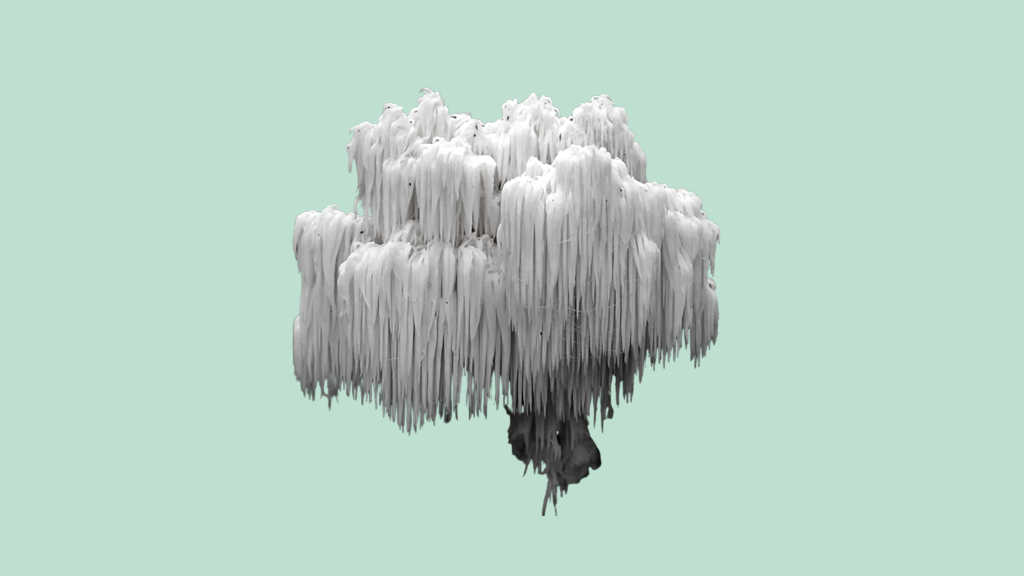Bear's tooth mushrooms (Hericium americanum) are among the world's wildest and most exotic edible mushrooms. Due to the isolation of the areas where it grows, this species is difficult to locate.
Hericium americanum profile
| Scientific name | Scientific name: Hericium americanum |
| Family name | Hericiaceae (tooth fungi) |
| Plant type | Edible mushroom |
| Class | Agaricomycetes |
| Order | Russulales |
Common names include:
- Bear’s tooth fungus
- Bear’s head tooth fungus
- Pom pom mushroom
- Hedgehog mushroom
- Lion’s mane tooth
- Old man’s beard
- Satyr’s beard
- Bearded hedgehog mushroom
Known botanically as Hericium americanum, bear’s tooth mushrooms are North America’s only Hericium species and belong to the Hericiaceae family.
Is Bear’s Tooth Mushroom Rare?
While it may not be considered extremely rare, it’s not as common to find these mushrooms as they are quite localized.
What Are You Foraging For Right Now?
We're thrilled to hear your ideas. What would you like to submit today? Feel free to share your thoughts and experiences with us.
Bear’s tooth mushroom is often associated with hardwood trees, particularly oak and beech. Its habitat specificity means it may be more prevalent in mature forests with these tree species.
How Do You Identify a Bear’s Tooth Mushroom?
Here’s my guide to help you identify bear’s tooth mushroom:
Fruitbody: Bear’s tooth mushroom has a large, cascading, and pom-pom-like structure with hanging, icicle-like spines. The spines resemble the teeth of a beard or mane.
Branching Structure: The mushroom often has a central branching structure from which the spines hang, resembling a cascading mass.
Color: The mushroom is typically white to creamy in color.
No Gills or Pores: Unlike many mushrooms, bear’s tooth mushroom does not have traditional gills or pores. The spines are directly attached to the branching structure.
Size: It can grow quite large. Individual mushrooms can range from a few inches to several inches in diameter.
Spore Print: White-spored mushroom.
Texture: The spines are soft and tooth-like. The entire mushroom has a delicate and tender texture.
Smell: Bear’s tooth is often described as having little to no distinct smell.
Season: Bear’s tooth mushroom typically fruits in late summer to fall. Look for it during this period.
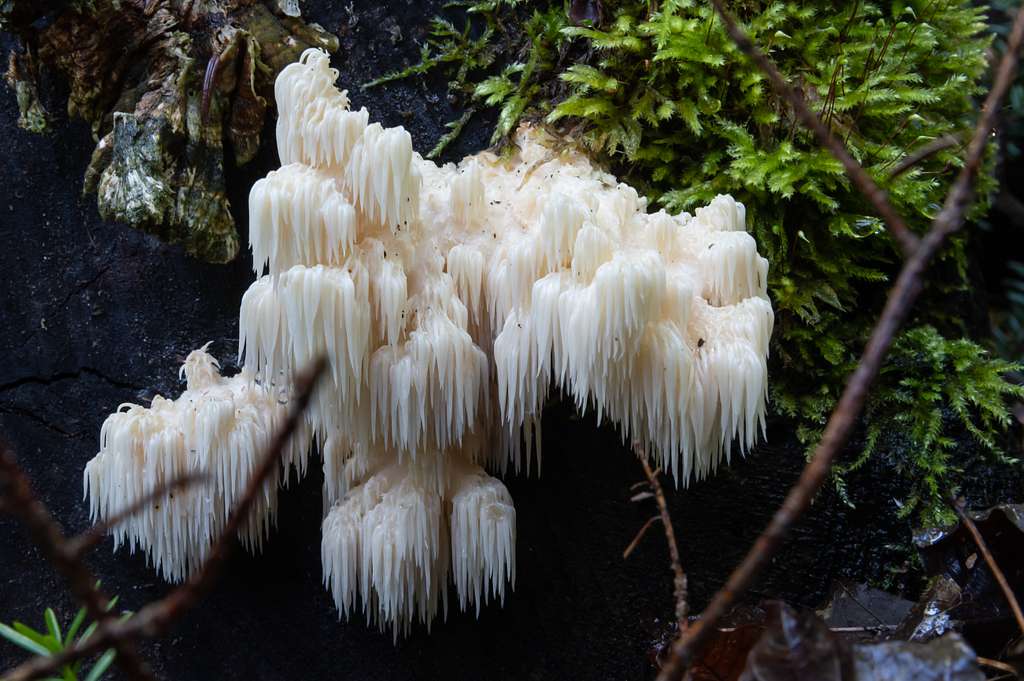
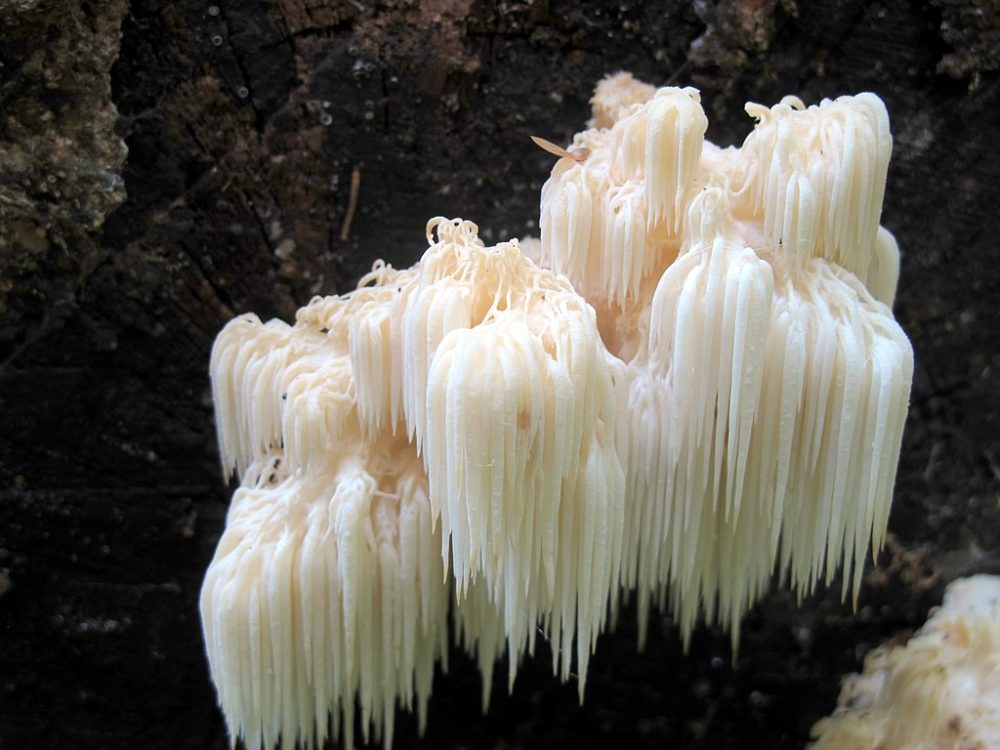
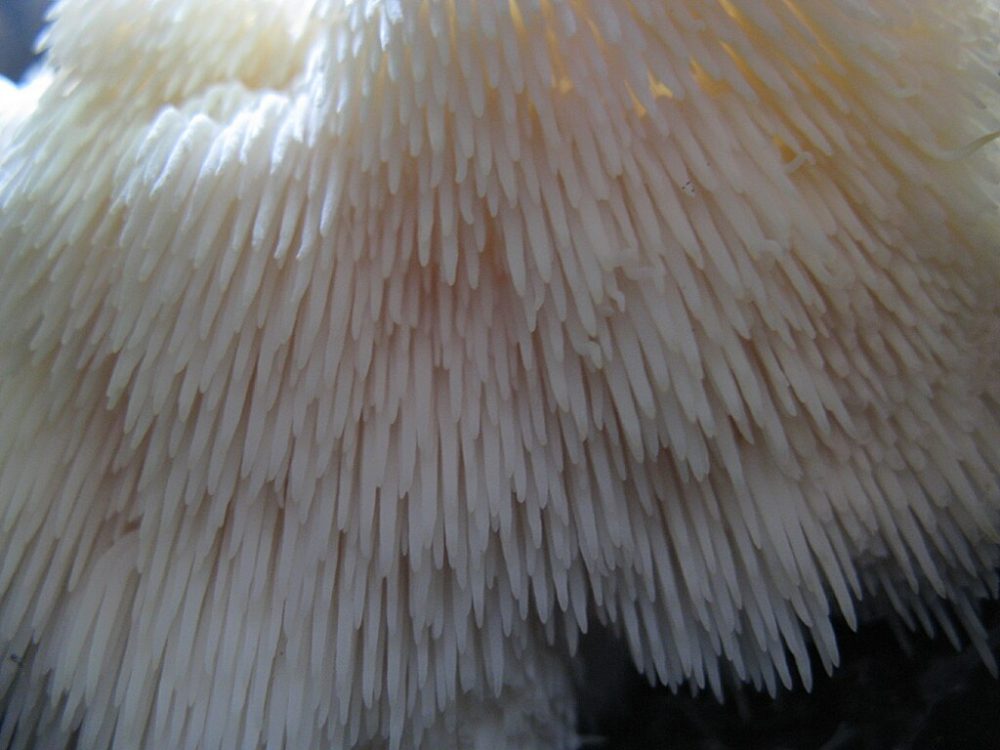
Is Bear’s Head Tooth the Same as Lion’s Mane?
Lion’s mane is a sibling of the bear’s head tooth mushroom. They both pertain to the Hericium species.
There is aslight difference between a bear’s tooth mushroom and a lion’s mane mushroom, with the mature bear’s head mushroom possessing branched fruiting bodies while the lion’s mane mushroom lacks them.

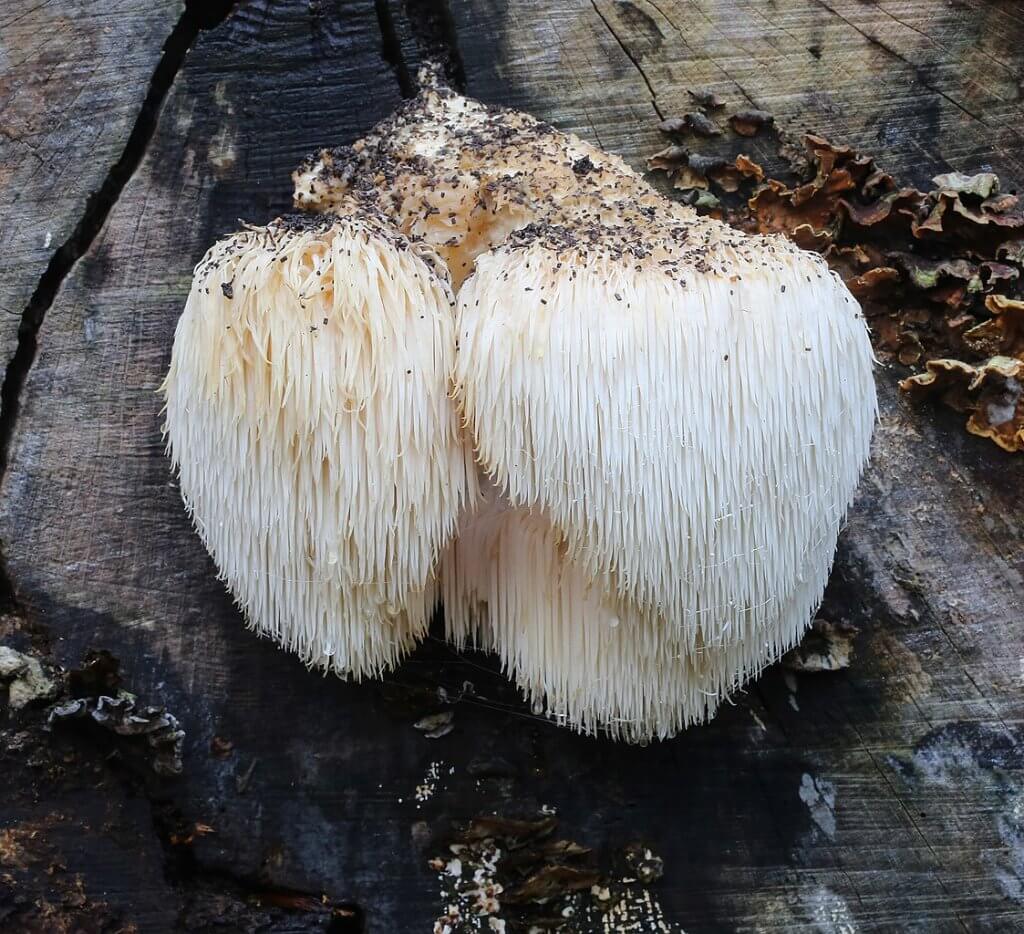
Is Bear’s Tooth Mushroom Edible?
H. americanum is an edible mushroom.
These mushrooms should be cooked before consumption and are best used in baking, sautéing, and frying applications.
What Does Bear’s Tooth Mushroom Taste Like?
Bear’s head mushrooms are very wild in nature, and their tastes and odors reflect this wildness. They have a fresh, earthy, natural flavor and aroma.
Having a mild, nutty taste and a sweet and fragrant undertone similar to lobster or crab, bear’s head mushrooms are tender and meaty when picked young and cooked.
Where does Bear’s Tooth Mushroom grow?
Bear’s tooth mushroom is commonly associated with mature hardwood forests. It often grows on the trunks or branches of hardwood trees, particularly on deciduous trees like oak, beech, and maple.
It can be found on both living and dead trees, including fallen logs and standing deadwood.
Other mushrooms you can find in a similar habitat include:
When is the Best Time to Forage for Bear’s Tooth Mushroom?
The primary fruiting season for bear’s tooth mushroom is August through October.
Bear’s tooth mushroom usually shows up when it’s cooler, and there’s enough moisture around. Rain and humidity are key factors that make the conditions right for these mushrooms to appear.
Are There Any Lookalikes?
Bear’s tooth mushrooms do not have poisonous lookalikes.
Here are a few edible mushrooms that may resemble bear’s tooth mushrooms, along with some key differences:
Lion’s Mane Mushroom (Hericium erinaceus): EDIBLE
Differences: While lion’s mane shares the same genus with bear’s tooth mushroom, the spines of lion’s mane are typically longer and more shaggy, resembling a lion’s mane. Bear’s tooth mushroom has shorter, icicle-like spines.
Hedgehog Mushroom (Hydnum repandum): EDIBLE
Differences: Hedgehog mushrooms have spines instead of gills. Hedgehog spines are shorter and more densely packed compared to the elongated spines of bear’s tooth mushroom.
Coral Tooth Fungus (Hericium coralloides): EDIBLE
Differences: While the name is similar, coral tooth fungus (also known as comb tooth) has a coral-like appearance with branches. It lacks the pom-pom or beard-like structure.
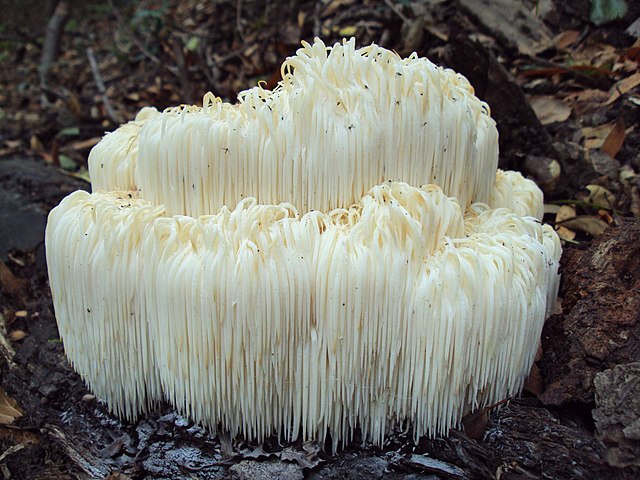


What Are the Health Benefits of Consuming Bear’s Tooth Mushroom?
While bear’s tooth mushroom is primarily valued for its deliciousness in recipes, it is also considered a medicinal mushroom:
Nutrient Content: Bear’s tooth mushroom is a good source of various nutrients, including vitamins, minerals, and antioxidants.
Immunomodulatory Properties: They may help support the immune system, but more research is needed to establish specific mechanisms and benefits.
Neuroprotective Effects: Certain compounds found in Bear’s Tooth Mushroom, such as hericenones and erinacines, have been studied for their potential neuroprotective effects. These compounds may have positive impacts on nerve growth and function.
Gut Health: The consumption of certain mushrooms, including bear’s tooth mushroom, may have positive effects on gut health. Mushrooms contain dietary fiber and prebiotics that can support a healthy gut microbiota.
Antioxidant Activity: The presence of antioxidants in bear’s tooth mushroom may help combat oxidative stress in the body, potentially reducing the risk of chronic diseases.
For more information about medicinal mushrooms used to increase gut health, check out our video below!
What Recipes Can You Use Bear’s Tooth Mushroom In?
Bear’s tooth mushroom is a versatile and tasty addition to many dishes. Here are some great recipe ideas:
- Sautéed Bear’s Tooth Mushrooms:
- Heat some butter or olive oil in a pan.
- Sauté bear’s tooth mushroom until golden brown.
- Season with salt, pepper, and your favorite herbs.
- Grilled bear’s tooth mushrooms:
- Toss the mushrooms in olive oil, garlic, and herbs.
- Grill them until they’re nicely charred and tender.
- Serve as a side or on top of a juicy steak.
- Bear’s tooth mushroom pasta:
- Sauté mushrooms with garlic and onions.
- Mix them into your favorite pasta with Parmesan cheese.
- Add a splash of cream for a creamy texture.
- Bear’s tooth mushroom risotto:
- Stir sautéed mushrooms into a pot of creamy risotto.
- Finish with a sprinkle of fresh herbs and grated cheese.
- Bear’s tooth mushroom pizza:
- Use sautéed Bear’s Tooth Mushrooms as a pizza topping.
- Add mozzarella, caramelized onions, and a drizzle of balsamic glaze.
- Bear’s tooth mushroom stir-fry:
- Quickly stir-fry mushrooms with your favorite veggies and protein.
- Toss in a flavorful sauce made with soy sauce, ginger, and garlic.
- Bear’s tooth mushroom omelette:
- Include sautéed mushrooms in your morning omelette.
- Add cheese, herbs, and any other desired fillings.
These are the two of our favorite bear’s tooth mushroom recipes:
- Wild mushroom rangoon with bear’s tooth mushrooms
- Hericium mushroom miso soup
- “Crab” linguine with hericium

It is recommended that they be consumed as soon as possible, as if kept in the refrigerator for more than a few days, they may become bitter.
Ana has always been interested in all things nature and flora. With her expertise in home gardening and interest in foraging, she has been spending her weekends and free time looking for edible native plants, flowers, and fungi. One of her many hobbies includes testing new savory and sweet recipes, juices or teas made from freshly picked plants, wild fruits, or mushrooms.

